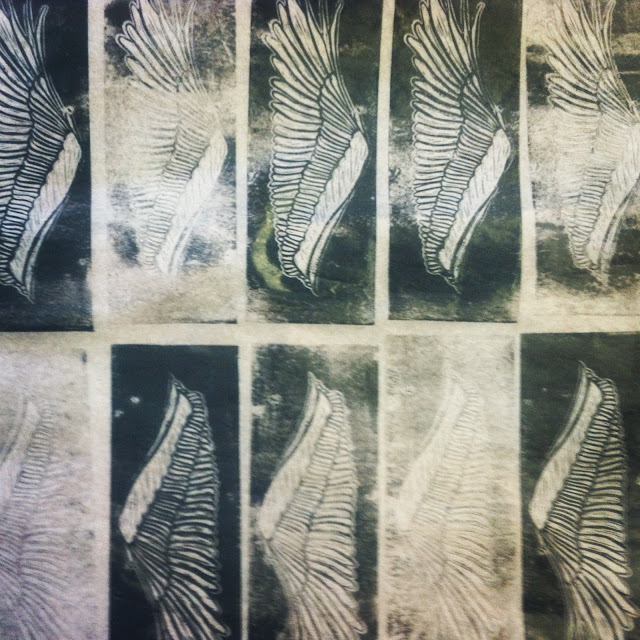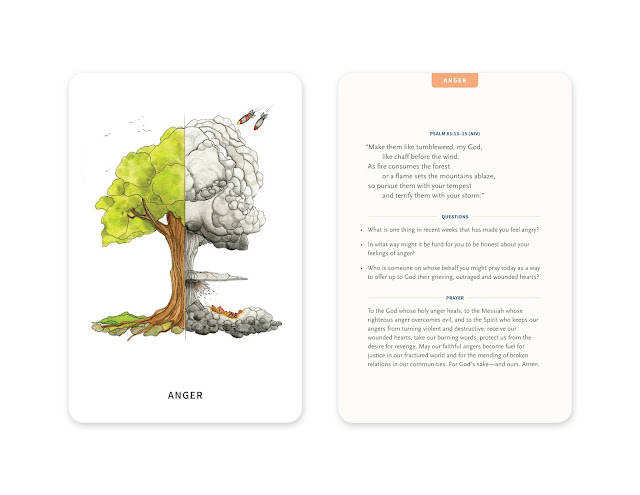The vocation of artists: a class syllabus
The following is syllabus material for the course that I teach on the vocation of artists. The only thing I'll mention here, of a critical nature, is that a syllabus always involves the unenviable matter of choice. What do you choose to include and what do you choose to exclude? So many other resources could have been included here, and perhaps should have been included.
But since this is an ongoing venture, I allow myself a pinch of grace to get it better the next time around, trusting that this year's students will supply me with the kind of feedback that will enable the course to become even more helpful to future students.
“It is our duty . . . to love and praise the created order, because, as is made manifest in Jesus Christ, it is so mysteriously well-pleasing to God.” – Karl Barth
“So after 16 years of writing books and 10 years of failing to find a publisher, why do I keep trying? I ask myself this every day.” – Anjali Enjeti
THE VOCATION OF AN ARTIST:
IN BIBLICAL, HISTORICAL, THEOLOGICAL & CONTEMPORARY PERSPECTIVE
Course Description:
This course introduces the student to biblical, theological, historical and contemporary models for the vocation of an artist and offers a vocational model that seeks to encompass a broad range of professions, stations of life and cultural contexts. With this broad perspective in mind, students will explore examples within the arts where artists have articulated their sense of calling; the virtues, practices and spiritual disciplines of an artistic vocation; the biblical, theological and spiritual contours of a mature human life; the aesthetic dimension of an artist’s calling; the practical conditions of a flourishing artist; and the mission of a believer artist in light of God’s mission in the world.
Learning Outcomes:
The basic aim of this course is for students to discern the shape of a flourishing artist. Upon completion of this course, students will: (1) have a working knowledge of biblical, theological and historical models of an artist’s vocation; (2) be able to articulate contemporary understandings of the vocation of an artist as well as “read” works of art in which ideas about the vocation of an artist are expressed; 3) be able to articulate one’s own convictions about an artist’s vocation; and (4) be able to discern the basic shape of ministry to artists.
Course Assignments:
In addition to 1,350 pages of required reading, lectures, class and online discussion, students are being asked 1) to write an essay, in conversation with Madeleine L’Engle OR Anne Lamott, in which they examine the ways in which family, church and society, past and present, have shaped their ideas about the vocation of an artist; 2) to write a review of the readings on theology and the arts; 3) to read a novel or biography/autobiography related to an artist's calling and to write a critical reflection on it; 4) to write up an interview that they conduct with an artist; and 5) in conversation with the work completed in previous assignments, to advance an argument on the vocation of an artist, appealing to specific historical, biblical, theological and contemporary perspectives.
 |
| Luz ascendente ("Amen of creation") |
“I can’t put it in words yet what I’ve gained from making this film. I’m in a better place as a filmmaker, I’m in a better place as a husband, and I’m in a better place as a human being." – David Lowery
"What do I hate about acting? The flop sweat, the sweat that comes from the fear of failing."– Jeff Bridges
Topics covered:
1. On the fundamental calling of artists: to love the world, as God so loves the world, as the beloved of God.
2. Theological perspectives on the vocation of artists: God’s creation, Christ’s vocation, the Holy Spirit’s inspiration.
3. Aesthetic perspectives on the vocation of artists.
4. Biblical perspectives on the vocation of artists: Genesis, Psalms, Gospels, Hebrews, Revelation.
5. Historical perspectives on the vocation of artists: Patristic, Medieval, Reformation, Modern.
6. Contemporary perspectives on the vocation of artists.
7. Biographical perspectives on the vocation of artists.
8. Fictionalized perspectives on the vocation of artists.
9. The virtues, practices and spiritual disciplines of a faithful artist.
10. The mission of a believer artist in light of God’s mission in the world.
Required Reading (BOOKS):
1. Bayles David and Ted Orland, Art and Fear: Observations On the Perils (and Rewards) of Artmaking. Eugene, OR: Continuum, 1993.
2. Currey, Mason. Daily Rituals: How Artists Work. New York: Knopf, 2013.
3. L’Engle, Madeleine. Walking on Water: Reflections on Faith and Art. Waterbrook Press, 2001. OR: Anne Lamott. Bird by Bird: Some Instructions on Writing and Life. Anchor Press, 1995.
4. Taylor, W. David O., ed., For the Beauty of the Church: Casting a Vision for the Arts. Grand Rapids: Baker, 2010.
5. Wainwright, Geoffrey. For Our Salvation: Two Approaches to the Work of Christ. Grand Rapids: Eerdmans, 1997.
Possible biographies or autobiographies:
Rolland Hein, George MacDonald: Victorian Mythmaker; Humphrey Carpenter, Tolkien; Misty Copeland, Life in Motion: An Unlikely Ballerina; Frederick Buechner, Now and Then: A Memoir of Vocation; Giorgio Vasari, The Lives of Artists; Flannery O’Connor, Mystery and Manners; Christoph Wolff, Johann Sebastian Bach: The Learned Musician; John Stubbs, John Donne: The Reformed Soul: A Biography; John R. Tyson, Assist Me to Proclaim: The Life and Hymns of Charles Wesley; Anne Lamott, Traveling Mercies; Bono in conversation with Michka Assayas; or TBD.
Possible novels:
Marly Youmans, Glimmerglass: A Novel; Oscar Wilde, The Picture of Dorian Gray; Michael Chabon, The Amazing Adventures of Kavalier & Clay; Emily St. John Mandel, Station Eleven; Donna Tartt, The Goldfinch: A Novel; Ron Hansen, Exiles; Chaim Potok, My Name is Asher Lev; Irving Stone, The Agony and the Ecstasy: A Biographical Novel of Michelangelo; Steven Galloway, The Cellist of Sarajevo; or TBD
Required Reading (a selection of required ESSAYS):
* Jeremy Begbie, Voicing Creation’s Praise, “Christ, Creation and Creativity”
* “Amnesia Therapy: A pastor seeks to revive Houston's memory with art”
* James Watkins, “Theological Models for Human Creativity in Twentieth-Century Theologies of Art”
* Andy Crouch, Culture Making, chs. 6-11
* Image Journal, issue #93, “The Film the World Needs Now: A Roundtable Discussion”
* Deborah Haynes, The Vocation of the Artist, chs. 5-7
* "Two Philly artists win prestigious national grants for finding humanity behind bars”
* Jenefer Robinson, “The Emotions in Art,” in The Blackwell Guide to Aesthetics
* James K. A. Smith, Imagining the Kingdom: How Worship Works, “Imaginative, Narrative Animals”
* “Favela Painting Foundation Is Using Art To Rejuvenate Brazil’s Slums”
* Gesa Elsbeth Thiessen, Theological Aesthetics, “Patristic theologians on the Divine Artist”
* Flannery O’Connor, “Novelist and Believer”
* David Taylor, The Theater of God’s Glory, “A Trinitarian Theology of the Physical Body”
* “Amena Brown Q+A: Poetry in an Age of Lament: How the spoken-word poet uses art to speak truth about race, faith, and womanhood”
* Walker Percy, “On Being a Catholic Novelist”
* Jeanne Murray Walker, “On Poets and Poetry”
* Watch TED talk, “RSA ANIMATE: The Divided Brain” via psychiatrist Iain McGilchrist’s book, The Master and his Emissary
* Mako Fujimura, “Our Calling in the Starry Night”
* Pope John Paul II, “Letter of His Holiness Pope John Paul II to Artists”
* Excerpts from Manjula Martin, Scratch: Writers, Money, and the Art of Making a Living
* Christopher Zara, Tortured Artists, Introduction
* Contemporary Art and The Church: A Conversation Between Two Worlds, “Contemporary Artists in the Public Square: A Symposium”
* William Deresiewicz, “The Death of the Artist—and the Birth of the Creative Entrepreneur”
* Priscilla Frank, “What Experts Got Wrong about the Relationship between Suffering and Art”
* Emily Browne, “10 things about being an artist that art teachers don’t tell you.”
* J. K. Rowling, Very Good Lives: The Fringe Benefits of Failure and the Importance of Imagination
 |
| Planetary gears ("Amen of the ringed planet") |
“If grace is everywhere, it seems very likely…that it may be where people are.” – Andrew Greeley
“Art challenges the ‘I’ that we are and asks us to see beyond our own assumptions, prejudices, and templates…. Art won’t let you sleepwalk from one experience to another, going through the motions of life. Art keeps you alert, not in the hyper, super-exhausted state of video games and too much TV, but alert to life, its beauty, and its complexity.”
– Jeannette Winterson
– Jeannette Winterson







Comments
And glad to hear of your interest in Sayers, Peter.